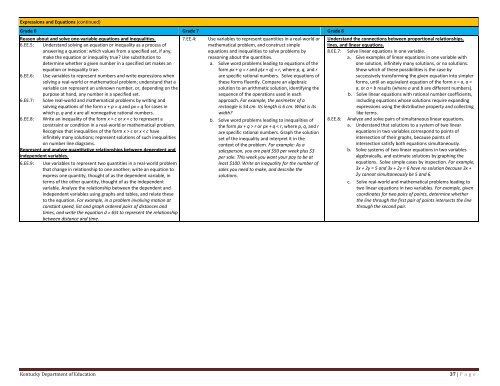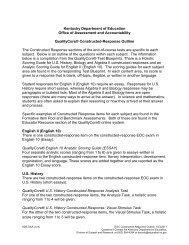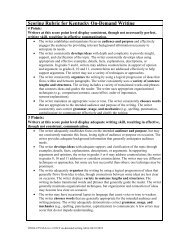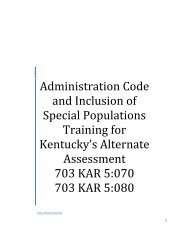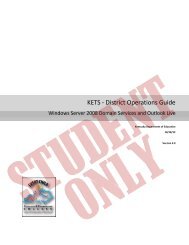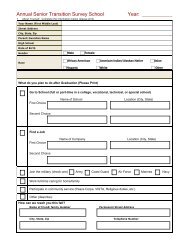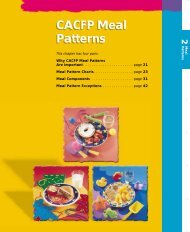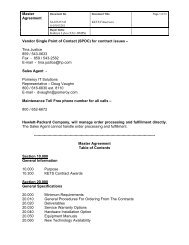Standards with Progressions grades K-HS v. 1.3 - Kentucky ...
Standards with Progressions grades K-HS v. 1.3 - Kentucky ...
Standards with Progressions grades K-HS v. 1.3 - Kentucky ...
- No tags were found...
You also want an ePaper? Increase the reach of your titles
YUMPU automatically turns print PDFs into web optimized ePapers that Google loves.
Expressions and Equations (continued)<br />
Grade 6 Grade 7 Grade 8<br />
Reason about and solve one-variable equations and inequalities.<br />
7.EE.4:<br />
6.EE.5: Understand solving an equation or inequality as a process of<br />
answering a question: which values from a specified set, if any,<br />
make the equation or inequality true Use substitution to<br />
determine whether a given number in a specified set makes an<br />
equation or inequality true.<br />
6.EE.6: Use variables to represent numbers and write expressions when<br />
solving a real-world or mathematical problem; understand that a<br />
variable can represent an unknown number, or, depending on the<br />
purpose at hand, any number in a specified set.<br />
6.EE.7: Solve real-world and mathematical problems by writing and<br />
solving equations of the form x + p = q and px = q for cases in<br />
which p, q and x are all nonnegative rational numbers.<br />
6.EE.8: Write an inequality of the form x > c or x < c to represent a<br />
constraint or condition in a real-world or mathematical problem.<br />
Recognize that inequalities of the form x > c or x < c have<br />
infinitely many solutions; represent solutions of such inequalities<br />
on number line diagrams.<br />
Represent and analyze quantitative relationships between dependent and<br />
independent variables.<br />
6.EE.9:<br />
Use variables to represent two quantities in a real-world problem<br />
that change in relationship to one another; write an equation to<br />
express one quantity, thought of as the dependent variable, in<br />
terms of the other quantity, thought of as the independent<br />
variable. Analyze the relationship between the dependent and<br />
independent variables using graphs and tables, and relate these<br />
to the equation. For example, in a problem involving motion at<br />
constant speed, list and graph ordered pairs of distances and<br />
times, and write the equation d = 65t to represent the relationship<br />
between distance and time.<br />
Use variables to represent quantities in a real-world or<br />
mathematical problem, and construct simple<br />
equations and inequalities to solve problems by<br />
reasoning about the quantities.<br />
a. Solve word problems leading to equations of the<br />
form px + q = r and p(x + q) = r, where p, q, and r<br />
are specific rational numbers. Solve equations of<br />
these forms fluently. Compare an algebraic<br />
solution to an arithmetic solution, identifying the<br />
sequence of the operations used in each<br />
approach. For example, the perimeter of a<br />
rectangle is 54 cm. Its length is 6 cm. What is its<br />
width<br />
b. Solve word problems leading to inequalities of<br />
the form px + q > r or px + q < r, where p, q, and r<br />
are specific rational numbers. Graph the solution<br />
set of the inequality and interpret it in the<br />
context of the problem. For example: As a<br />
salesperson, you are paid $50 per week plus $3<br />
per sale. This week you want your pay to be at<br />
least $100. Write an inequality for the number of<br />
sales you need to make, and describe the<br />
solutions.<br />
Understand the connections between proportional relationships,<br />
lines, and linear equations.<br />
8.EE.7: Solve linear equations in one variable.<br />
a. Give examples of linear equations in one variable <strong>with</strong><br />
one solution, infinitely many solutions, or no solutions.<br />
Show which of these possibilities is the case by<br />
successively transforming the given equation into simpler<br />
forms, until an equivalent equation of the form x = a, a =<br />
a, or a = b results (where a and b are different numbers).<br />
b. Solve linear equations <strong>with</strong> rational number coefficients,<br />
including equations whose solutions require expanding<br />
expressions using the distributive property and collecting<br />
like terms.<br />
8.EE.8: Analyze and solve pairs of simultaneous linear equations.<br />
a. Understand that solutions to a system of two linear<br />
equations in two variables correspond to points of<br />
intersection of their graphs, because points of<br />
intersection satisfy both equations simultaneously.<br />
b. Solve systems of two linear equations in two variables<br />
algebraically, and estimate solutions by graphing the<br />
equations. Solve simple cases by inspection. For example,<br />
3x + 2y = 5 and 3x + 2y = 6 have no solution because 3x +<br />
2y cannot simultaneously be 5 and 6.<br />
c. Solve real-world and mathematical problems leading to<br />
two linear equations in two variables. For example, given<br />
coordinates for two pairs of points, determine whether<br />
the line through the first pair of points intersects the line<br />
through the second pair.<br />
<strong>Kentucky</strong> Department of Education<br />
37 | P a g e


